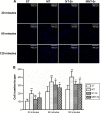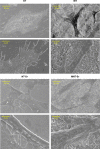Effects of a micro/nano rough strontium-loaded surface on osseointegration
- PMID: 26213468
- PMCID: PMC4509532
- DOI: 10.2147/IJN.S84398
Effects of a micro/nano rough strontium-loaded surface on osseointegration
Abstract
We developed a hierarchical hybrid micro/nanorough strontium-loaded Ti (MNT-Sr) surface fabricated through hydrofluoric acid etching followed by magnetron sputtering and evaluated the effects of this surface on osseointegration. Samples with a smooth Ti (ST) surface, micro Ti (MT) surface treated with hydrofluoric acid etching, and strontium-loaded nano Ti (NT-Sr) surface treated with SrTiO3 target deposited via magnetron sputtering technique were investigated in parallel for comparison. The results showed that MNT-Sr surfaces were prepared successfully and with high interface bonding strength. Moreover, slow Sr release could be detected when the MNT-Sr and NT-Sr samples were immersed in phosphate-buffered saline. In in vitro experiments, the MNT-Sr surface significantly improved the proliferation and differentiation of osteoblasts compared with the other three groups. Twelve weeks after the four different surface implants were inserted into the distal femurs of 40 rats, the bone-implant contact in the ST, MT, NT-Sr, and MNT-Sr groups were 39.70%±6.00%, 57.60%±7.79%, 46.10%±5.51%, and 70.38%±8.61%, respectively. In terms of the mineral apposition ratio, the MNT-Sr group increased by 129%, 58%, and 25% compared with the values of the ST, MT, and NT-Sr groups, respectively. Moreover, the maximal pullout force in the MNT-Sr group was 1.12-, 0.31-, and 0.69-fold higher than the values of the ST, MT, and NT-Sr groups, respectively. These results suggested that the MNT-Sr surface has a synergistic effect of hierarchical micro/nano-topography and strontium for enhanced osseointegration, and it may be a promising option for clinical use. Compared with the MT surface, the NT-Sr surface significantly improved the differentiation of osteoblasts in vitro. In the in vivo animal experiment, the MT surface significantly enhanced the bone-implant contact and maximal pullout force than the NT-Sr surface.
Keywords: implant; micro/nanorough; surface modification.
Figures












Similar articles
-
Effect of titanium implants with strontium incorporation on bone apposition in animal models: A systematic review and meta-analysis.Sci Rep. 2017 Nov 14;7(1):15563. doi: 10.1038/s41598-017-15488-1. Sci Rep. 2017. PMID: 29138499 Free PMC article.
-
Effects of micro/nano strontium-loaded surface implants on osseointegration in ovariectomized sheep.Clin Implant Dent Relat Res. 2019 Apr;21(2):377-385. doi: 10.1111/cid.12719. Epub 2019 Feb 4. Clin Implant Dent Relat Res. 2019. PMID: 30715786
-
The effects of Sr-incorporated micro/nano rough titanium surface on rBMSC migration and osteogenic differentiation for rapid osteointegration.Biomater Sci. 2018 Jun 25;6(7):1946-1961. doi: 10.1039/c8bm00473k. Biomater Sci. 2018. PMID: 29850672
-
Osseointegration effects of local release of strontium ranelate from implant surfaces in rats.J Mater Sci Mater Med. 2019 Oct 12;30(10):116. doi: 10.1007/s10856-019-6314-y. J Mater Sci Mater Med. 2019. PMID: 31606798 Free PMC article.
-
Osseointegration of titanium, titanium alloy and zirconia dental implants: current knowledge and open questions.Periodontol 2000. 2017 Feb;73(1):22-40. doi: 10.1111/prd.12179. Periodontol 2000. 2017. PMID: 28000277 Review.
Cited by
-
Synergistic effect of nanotopography and bioactive ions on peri-implant bone response.Int J Nanomedicine. 2017 Jan 27;12:925-934. doi: 10.2147/IJN.S126248. eCollection 2017. Int J Nanomedicine. 2017. PMID: 28184162 Free PMC article.
-
Sustained release of Sr and Ca from a micronanotopographic titanium surface improves osteoblast function.Biometals. 2025 Apr;38(2):623-646. doi: 10.1007/s10534-025-00668-8. Epub 2025 Mar 17. Biometals. 2025. PMID: 40097885
-
Effect of titanium implants with strontium incorporation on bone apposition in animal models: A systematic review and meta-analysis.Sci Rep. 2017 Nov 14;7(1):15563. doi: 10.1038/s41598-017-15488-1. Sci Rep. 2017. PMID: 29138499 Free PMC article.
-
Osteogenic activity of titanium surfaces with hierarchical micro-/nano-structures obtained by hydrofluoric acid treatment.Int J Nanomedicine. 2017 Feb 16;12:1317-1328. doi: 10.2147/IJN.S123930. eCollection 2017. Int J Nanomedicine. 2017. PMID: 28243092 Free PMC article.
-
Bone regenerating effect of surface-functionalized titanium implants with sustained-release characteristics of strontium in ovariectomized rats.Int J Nanomedicine. 2016 May 30;11:2431-42. doi: 10.2147/IJN.S101673. eCollection 2016. Int J Nanomedicine. 2016. PMID: 27313456 Free PMC article.
References
-
- Berglundh T, Persson L, Klinge B. A systematic review of the incidence of biological and technical complications in implant dentistry reported in prospective longitudinal studies of at least 5 years. J Clin Periodontol. 2002;29(Suppl 3):197–212. 232–233. - PubMed
-
- von Wilmowsky C, Moest T, Nkenke E, Stelzle F, Schlegel KA. Implants in bone: part II. Research on implant osseointegration: material testing, mechanical testing, imaging and histoanalytical methods. Oral Maxillofac Surg. 2014;18(4):355–372. - PubMed
-
- Yin K, Wang Z, Fan X, Bian Y, Guo J, Lan J. The experimental research on two-generation BLB dental implants – part I: surface modification and osseointegration. Clin Oral Implants Res. 2012;23(7):846–852. - PubMed
-
- Dohan Ehrenfest DM, Coelho PG, Kang BS, Sul YT, Albrektsson T. Classification of osseointegrated implant surfaces: materials, chemistry and topography. Trends Biotechnol. 2010;28(4):198–206. - PubMed
-
- Kim TI, Jang JH, Kim HW, Knowles JC, Ku Y. Biomimetic approach to dental implants. Curr Pharm Des. 2008;14(22):2201–2211. - PubMed
Publication types
MeSH terms
Substances
LinkOut - more resources
Full Text Sources
Research Materials

